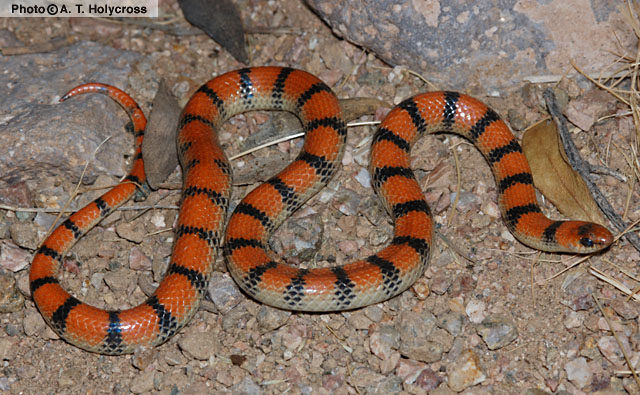|
| 질의: black snake | 결과: 71번째/314 | |
Common Ground Snake (Sonora semiannulata) - Wiki
| 제목: | Common Ground Snake (Sonora semiannulata) - Wiki
| |

| 해상도: 640x395
파일크기: 142402 Bytes
촬영일: 2005:12:30 10:05:45
등록시간: 2007:09:04 22:15:15
|
Sonora semiannulata
From Wikipedia, the free encyclopedia
[Photo] Groundsnake (Sonora semiannulata), Maricopa County, AZ. Photo (C) A.T.Holycross. Source: Reptiles of Arizona
The Common Ground Snake (Sonora semiannulata) is a species of small, harmless colubrid snake native to the southwestern United States, in Texas, New Mexico, Arizona, Oklahoma, Colorado, Kansas, Missouri, Utah and California, as well as northern Mexico, in Sonora, Chihuahua, Coahuila, Nuevo Leon, and Durango. It is sometimes referred to as the Western Ground Snake, or Variable Ground Snake as its patterning and coloration can vary widely, even within the same geographic region.
Description
Ground Snakes can grow from 10 to 15 inches in length. Their colors and patterns can vary widely. They can be brown, red, or orange, with black banding, orange or brown striping, or be solid colored. Their underside is typically white or grey. They have fairly smooth scales, a small head, and eyes with round pupils.
Behavior
Ground Snakes are typically nocturnal and secretive, but they are common throughout their range. Their preferred habitat is dry, rocky areas with loose soil. They are often found on roadsides, or in dry drainage ditches at night, foraging for food. Their diet consists primarily of invertebrates, such as spiders, scorpions, centipedes, crickets, and insect larvae. They are oviparous, breeding and laying eggs through the summer months.
Taxonomy
Sonora semiannulata was once broken up into five separate subspecies, based on the vast differences in color and patterning that the species displays, but recent research has shown that the various colors and patterns of Ground Snake interbreed indiscriminantly, making distinction between them impossible and thus not warranting subspecies status, though some sources still refer to them - using geography as a basis rather than morphology.
http://en.wikipedia.org/wiki/Sonora_semiannulata
| The text in this page is based on the copyrighted Wikipedia article shown in above URL. It is used under the GNU Free Documentation License. You may redistribute it, verbatim or modified, providing that you comply with the terms of the GFDL. |
|
^o^
동물그림창고 똑똑전화 누리집
^o^
|
|